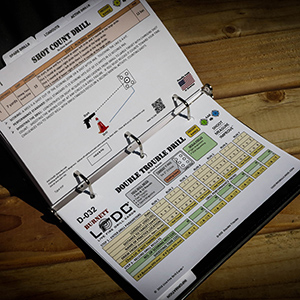Think back to your last trip to the range, did you improve? How about after that last 3-day defensive shooting class? Are you more accurate with your 9mm or your 45cal? What about that Dot Toutrue drill that you shot 6 months ago do you remember your score? Could you beat it today? What firearm did you use? What ammo runs best in that gun? Most shooters can’t answer these question with any degree of certainty.
If you are using a shooting journal (also known as a training log) you have data that will provide the answer. It may also help you spot skills that need a little more work. Over time you could have data that will tell you what brand of ammo and bullet weight that give you the tightest groups with a given firearm. These are just a few of the benefits of having an accurate log of your training. If you would ever need to show evidence of your training this could be indispensable.
The Journal
The journal can be as simple as a small notebook that you enter whatever details you feel are important to you, or a preprinted log with spaces labeled for a plethora of information about your range session. The most important thing to remember is to be consistent about keeping it up to date. I like to always keep mine in my range bag so that I can fill in my info while it is still fresh in my mind. If I am shooting a timed drill I like to keep a marker on me to write my times on the target so later there is no question what the time for that drill was.
What info to Track
As I said above if you are using a notebook track whats important to you. I will give you a few ideas, you can use them or not as you wish.
Loadout
- Firearm This is the firearm make and model, the caliber, Type of sights iron, laser or red dot. Is the trigger stock or Hi-performance, break weight, Barrel length, and any accessories flashlight, suppressor or any other.
- Ammo Manufacturer is it factory or a hand load bullet type and weight, pressure rating standard,+p or +p+ and maybe fps
- Holster Make, model, description
- Carry location appendix, side, back, shoulder, ankle or other
- Concealment Garments shirt out, shirt tucked in, coat/vest or other.
If you have several guns that you may shoot It can be convenient to give each loadout a nickname such as concealed #1 then each time you are shooting that loadout you would just note it as concealed #1.
Drill Information
- Date
- Distance to target (yards)
- Range name
- Draw from (concealment, open carry, low or compressed ready)
- Drill name
- # of scoring hits
- time (if it’s a timed drill)
- Accuracy (if the drill calls for 5 shots inside of a circle and you only hit 4 make a note).
- Skill Focus (if you are getting drills out of a book or off the web they will usually tell you what skills this drill focuses on).
Preprinted logs can make this a lot easier to keep organized and consistent. Most preprinted logs will have various spots for some combination of the information listed above as well as an area for notes.
A step up
This next log the Burnett Live Fire Drill Cards is not just a log but more of a total system. When I was first introduced to the Live Fire Drill Cards I knew immediately I would adopt this system.

This system is contained in a small 3 ring binder. Tabs divide the various parts.
The first tab is for the training log there is room for the date, the loadout used, Rounds fired, practice hours and a notes area to enter Goals, Plans, Drills run, Results, observations, Classes, and articles. Basically, anything you would like to record about the session.
The next tab is Loadout pages, we have already discussed what is involved in a loadout and this page has space for everything including the loadout ID.
Then we get to the drill tab. This begins with an index of forty-five drills. Each of the next forty-five pages is devoted to one of those drills.
The drill card as it is called will list everything you will need to run the drill including what target to use. (most of the targets can be downloaded and printed from the Live Fire Drill Cards web site).
There is also a notation of the skills focus of the drill.
There is a grid set up on the card to record all of your drill parameters. loadout, Draw from (concealment, open or ready), Grip used (s2h,s1h,w2h, or w1h.
There is so much more to this system. If you would like to see the whole system click here to visit their web site.
I am a strong believer that you can’t improve what you don’t measure. Using a log and recording each training session will help do that.